The Effect of Mining Activities on the Paleokarstic Features, Recent Karstic Features, and Karst Water of the Bakony Region (Hungary)
Abstract
:1. Introduction
2. Direct Mining Effects on the Karst
3. Indirect Effect on the Karst
4. The Artificial Water Level Lowering Resulted in the following Facts
- (1)
- Water level subsidence reached the margin of the mountains. At sites where the level was below the level of karst springs, the discharge of springs decreased (Spring lake of Hévíz), or they went dry (Tapolcafő springs). At the town of Tapolca, not only the spring of Lake Malom (Figure 7) went dry, but the cave providing this site with water went dry too.
- (2)
- Since the karst waters of the mountains flowed into the karstic floor of the surrounding basin (Little Hungarian Plain) and into its sediments, water level lowering could also be observed in the Little Hungarian Plain (Figure 6), and the direction of water flow partly changed (at some places water flow oriented towards the mountains).
5. Anthropogenic Pseudokarst Features Created through Mining
6. Conclusions
Funding
Informed Consent Statement
Data Availability Statement
Conflicts of Interest
References
- Kercsmár, Z.; Selmeczi, I.; Budai, T.; Less, G.; Konrád, G. Geology of the karst terrain sin Hungary. In Cave and Karst Systems of Hungary; Veress, M., Leél-Őssy, S., Eds.; Springer: Berlin/Heidelberg, Germany, 2022; in press. [Google Scholar]
- Haas, J. Földtan (Geology). In Magyarország Térképekben; Kocsis, K., Schweitzer, F., Eds.; MTA Földrazjtudományi Kutatóin-tézet: Budapest, Hungary, 2011; pp. 35–38. (In Hungarian) [Google Scholar]
- Jakucs, L. Morphogenetics of Karst Regions; Adam Hilgar: Bristol, UK, 1977; 284p. [Google Scholar]
- Ford, D.C.; Williams, P.W. Karst Hydrogeology and Geomorphology; John Wiley & Sons, Ltd.: Chichester, UK, 2007; 562p. [Google Scholar]
- Pécsi, M. A Pannóniái-medence morfogenetikája (The Morphogenesis of the Pannonian Basin). Földrajzi Értesítő 1980, 29, 105–127. (In Hungarian) [Google Scholar]
- Vadász, E. Bauxitföldtan (Bauxite Geology); Akadémia Kiadó: Budapest, Hungary, 1951; 127p. (In Hungarian) [Google Scholar]
- Mindszenty, A.; Sebe, K. Paleokarst in Hungary. In Cave and Karst Systems of the World; Veress, M., Leél-Őssy, S.Z., Eds.; Springer: Berlin/Heidelberg, Germany, 2022; in press. [Google Scholar] [CrossRef]
- Szabó, P. Magyarországi karsztformák klímatörténeti vonatkozásai (Relations between climate and karst features in Hungary). Földrajzi Közlemények 1956, 80, 183–189. (In Hungarian) [Google Scholar]
- Szabó, P.Z. Újabb adatok és megfigyelések a magyarországi őskarszt jelenségek ismeretében (New data and observations to the knowledge of Hungarian paleokarstic phenomena). Dunántúli Tudományos Gyűjtemény 1966, 58, 1–38. (In Hungarian) [Google Scholar]
- Veress, M.; Unger, Z.; Vetési-Foith, S. Anthropogenic pseudokarstic depression on Mount Bocskor (Bakony Region, Hungary). J. Earth Sci. 2022, in press. [Google Scholar]
- Vértes, L. Az Őskőkor és az Átmeneti Kőkor Emlékei Magyarországon (Paleolithic and Mesolithic Memories in Hungary); Akadémiai Kiadó: Budapest, Hungary, 1965; 385p. (In Hungarian) [Google Scholar]
- Mészáros, G.; Vértes, L. A Paint Mine from the Early Palaeolithic Age near Lovas. Acta Arch. 1995, 5, 1–34. [Google Scholar]
- Bárdossy, G. Adatok a Cserszegtomaji kaolinos agyag ismeretéhez (Some contributions to the knowledge of the kaolinitic clay of Cserszegtomaj). Földtani Közlöny 1959, LXXXIX, 374–380. (In Hungarian) [Google Scholar]
- Bárdossy, G. Karsztbauxitok (Karst Bauxites); Akadémia Kiadó: Budapest, Hungary, 1977; 413p. (In Hungarian) [Google Scholar]
- Cseh-Németh, J. Az Úrkúti mangánérc telep kifejlődési típusai (Development types of the manganese ore colony of Úrkút). Földtani Közlöny 1958, 88, 399–415. (In Hungarian) [Google Scholar]
- Juhász, Á. Évmilliók Emlékei (Memories of Millions of Years); Gondolat: Budapest, Hungary, 1983; 512p. (in Hungarian) [Google Scholar]
- Komlóssy, G.Y. The Iszkaszentgyörgy bauxite (SE Bakony, Mts. Hungary). Problems of genesis and mineral formation. Földtani Közlöny 1970, 95, 320–327. [Google Scholar]
- Mindszenty, A. A magyarországi bauxitok kutatásának rövid története (1903–2020) (A short history of Hungarian bauxite researches). Földtani Közlöny 2020, 150, 529–544. [Google Scholar] [CrossRef]
- Bulla, B. Néhány megjegyzés a tönkfelszínek kialakulásának kérdéséhez (Some remarks on the question of the development of peneplains). Földrajzi Értesítő 1958, VII, 257–274. (In Hungarian) [Google Scholar]
- Bíró, B. A halimbai és nyirádi bauxitelőfordulások karsztos fekvője (Karstic bedrock of the bauxite occurrences of Halimba and Nyirád). Földtani Közlöny 1969, 99, 98–104. (In Hungarian) [Google Scholar]
- Kálmán, G.; Pethő, J. Úrkút és Ajka környékének részletes karsztvíz térképe (Detailed kartswater map of the environs of Úrkút and Ajka). Hidrológiai Közlöny 1950, XXX, 175–178. (In Hungarian) [Google Scholar]
- Győrffy, D. Geomorfológiai tanulmányok a Káli-medencében (Geomorphological studies in the Kál Basin). Földrajzi Értesítő 1957, VI, 265–299. (In Hungarian) [Google Scholar]
- Veress, M.; Gadányi, P.; Tóth, G. Thermal Spring cones of the Tihany Peninsula. In Landscapes and Landforms of Hungary; Lóczy, D., Ed.; Springer: Berlin/Heidelberg, Germany; New York, NY, USA; Dordrecht, The Netherlands; London, UK, 2015; pp. 71–78. [Google Scholar]
- Veress, M.; Tóth, G. Kál-Basin: Pseudokarren on Sandstone. In Landscapes and Landforms of Hungary; Lóczy, D., Ed.; Springer: Berlin/Heidelberg, Germany; New York, NY, USA; Dordrecht, The Netherlands; London, UK, 2015; pp. 79–87. [Google Scholar] [CrossRef]
- Papp, F. Dunántúl karsztvizei és a feltárás lehetősége Budapesten (The karst waters of Transdanubia and the opportunity of exploration in Budapest). Hidrológiai Közlöny 1942, 21, 146–196. (In Hungarian) [Google Scholar]
- Csepregi, A. A karsztvíz kiemelés hatása a Dunántúli-Középhegység vízháztartására (The effect of karst water extraction on the water balance of the Transdanubian Mountains). In Bányászati Karsztvízszint Süllyesztés a Dunántúli-Középhegységben; Alföldi, L., Kapolyi, L., Eds.; MTA Földrajztudományi Kutatóintézet: Budapest, Hungary, 2007; pp. 77–112. (In Hungarian) [Google Scholar]
- Kozma, K. Az Ajkai Szénbányászat Története (History of Coal Mining in Ajka); Veszprémi Szénbányák: Veszprém, Hungary, 1991; 531p. (In Hungarian) [Google Scholar]
- Bakonyi Erőmű ZRT Bányászati Igazgatóság. Bányavágat Térképe 2004; Bakonyi Erőmű ZRT: Ajka, Hungary, 2004. [Google Scholar]
- Erdősi, F. A Társadalom Hatása a Felszínre, a Vizekre és az Éghajlatra a Mecsek tágabb Környezetében; Budapest Akadémia Kiadó: Budapest, Hungary, 1987; p. 228. ISBN 963-05-3885-7. [Google Scholar]
- Horányi, L.; Kolozsvári, G. Eodézia és Bányaméréstan: Bányaméréstan II; Tankönyvkiadó Budapest: Budapest, Hungary, 1989; p. 267. [Google Scholar]
- Sütő, L.; Homoki, E.; Németh, G. Felszínsüllyedési és Bolygatottsági Térkép Készítése a Kelet-Borsodi-szénmedencében. Geoinformatika és Domborzatmodellezés, HunDEM 2009 és GeoInfo Konferencia és Kerekasztal Válogatott Tanulmányai, Hungary, 24 April 2009. Available online: https://www.google.com/url?sa=t&rct=j&q=&esrc=s&source=web&cd=&cad=rja&uact=8&ved=2ahUKEwj4p6eAyKz7AhUV9zgGHanRAHIQFnoECA8QAQ&url=http%3A%2F%2Fwww.uni-miskolc.hu%2F~fkt%2FHundem_es_Geoinfo_2009%2FCikkek%2FSutoL_HomokiE_NemethG.pdf&usg=AOvVaw2mZDygeVfeYHJ8AHLCpKTg (accessed on 6 September 2022).
- Éri, I. Adatok a bakonyi üveghuták történetéhez (Data on the history of the glasshouses of the Bakony Mountains). A Veszprém M. Múzeumok Közleményei 1966, 5, 143–180. (In Hungarian) [Google Scholar]
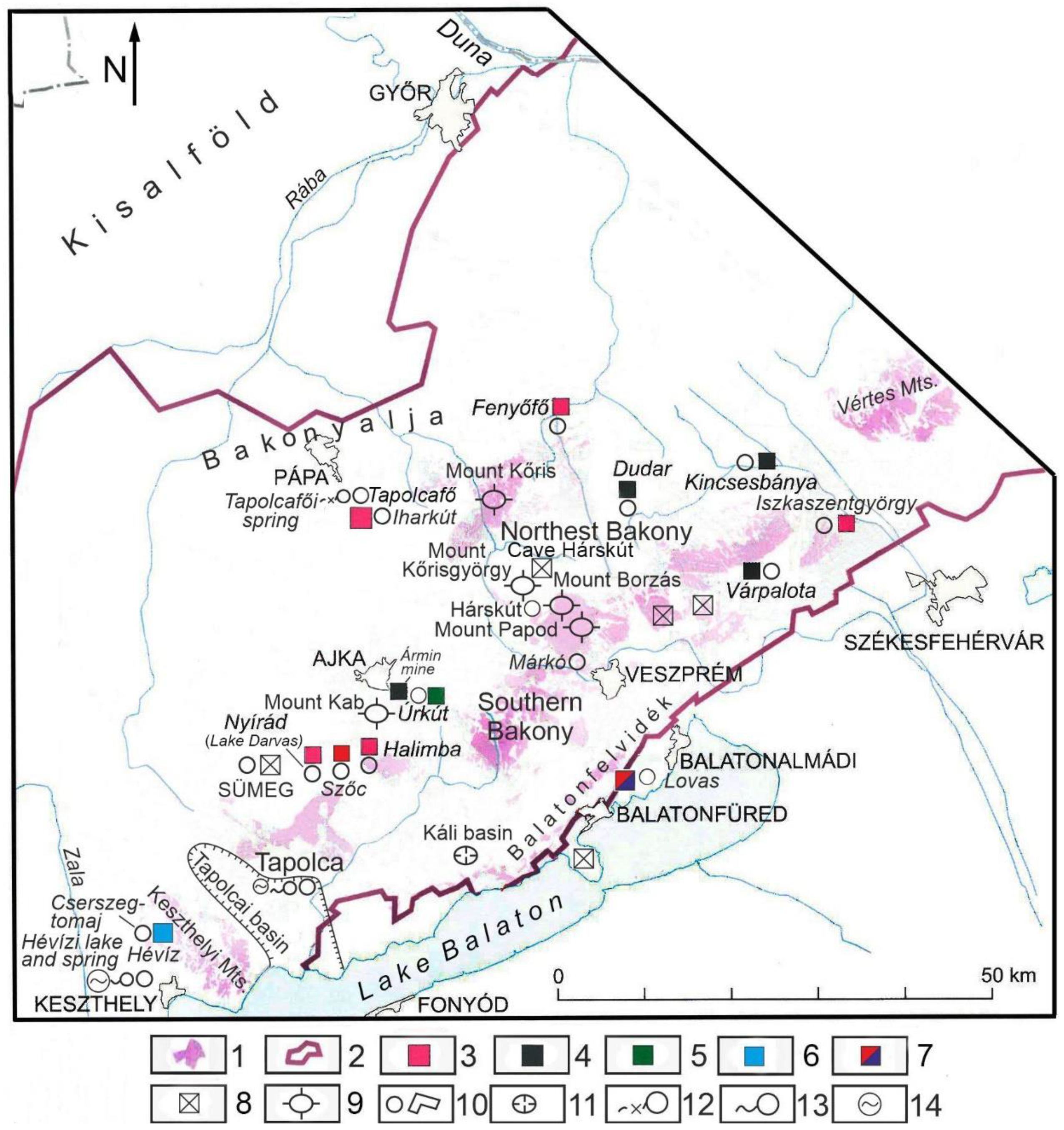
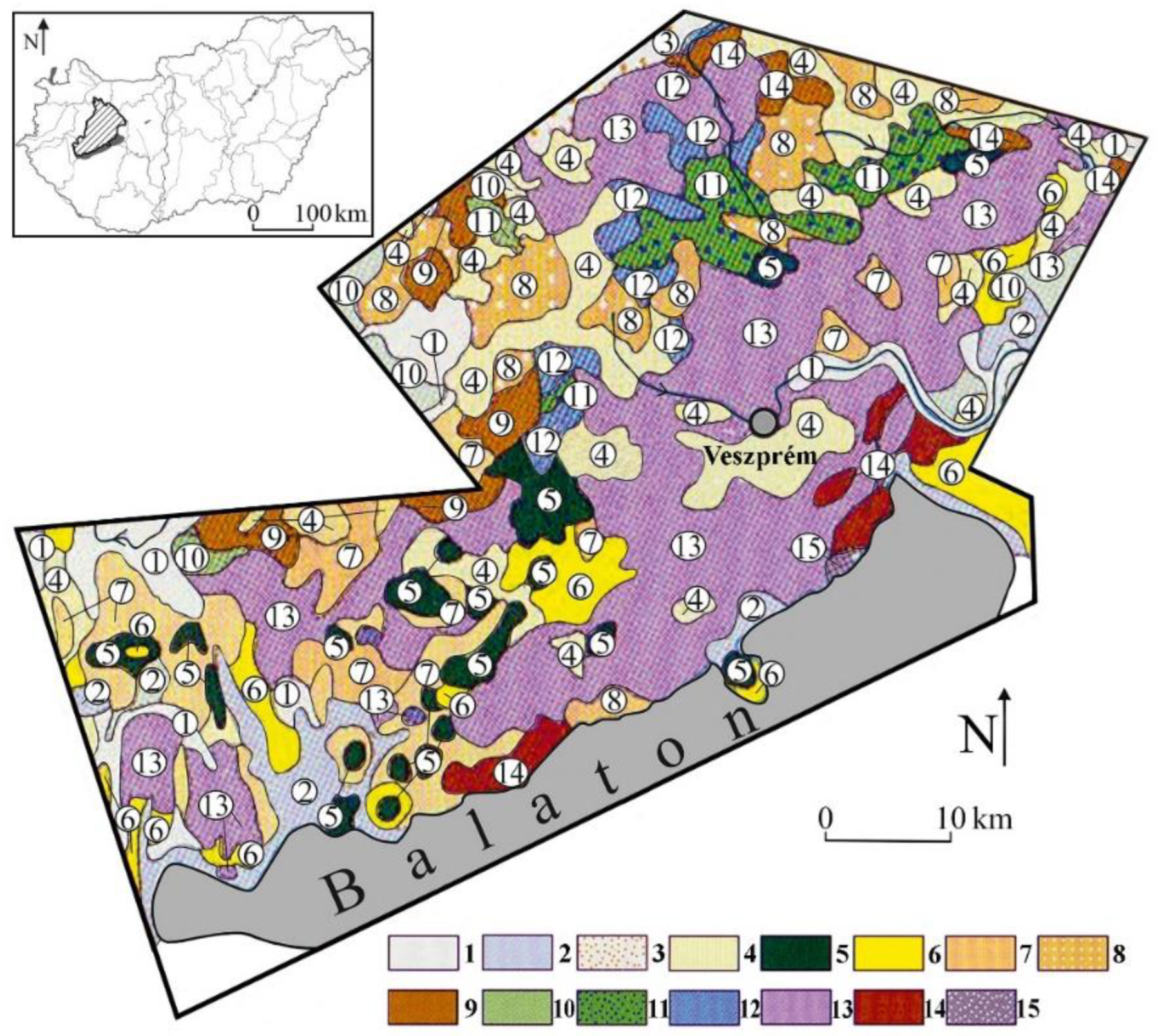
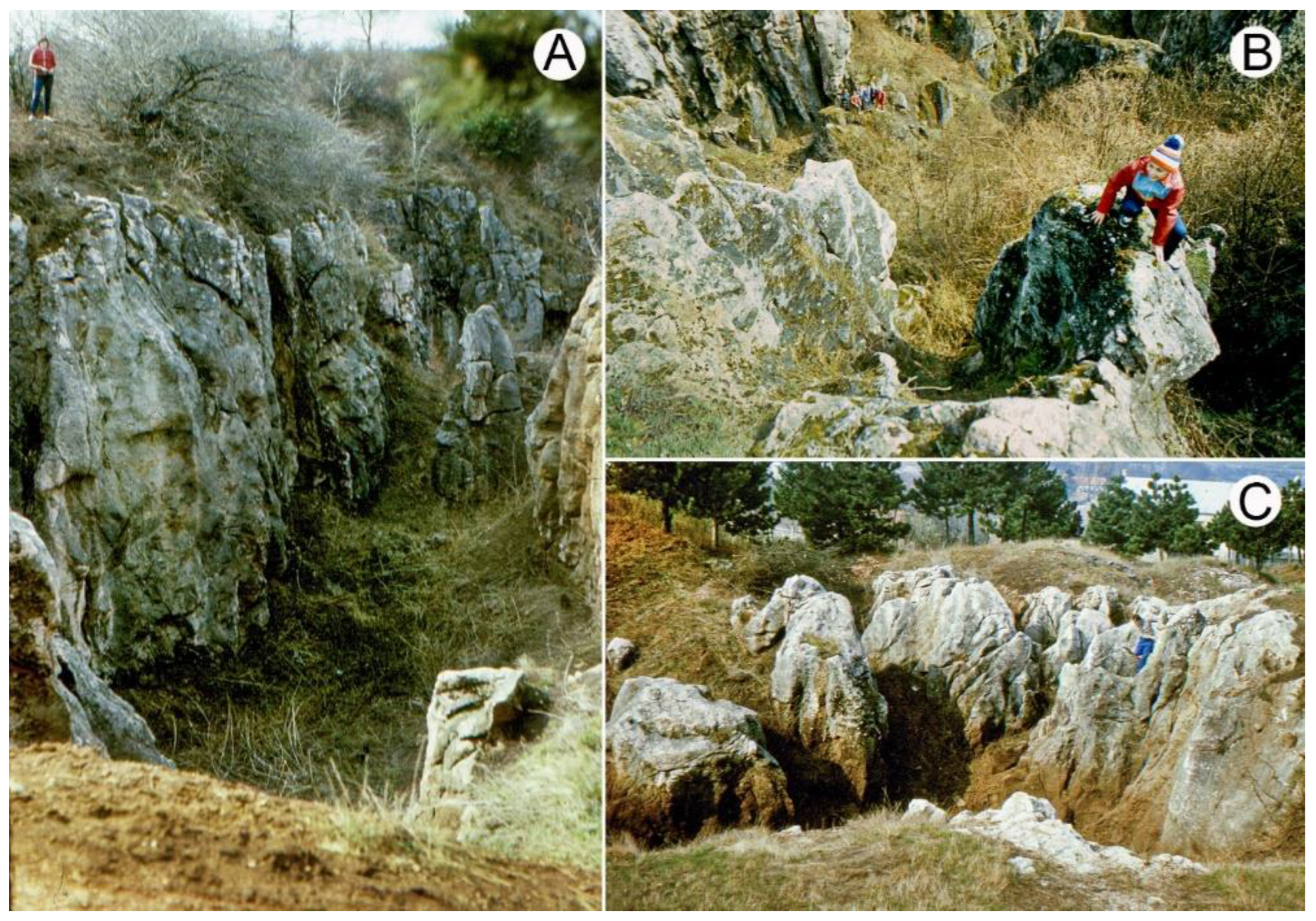
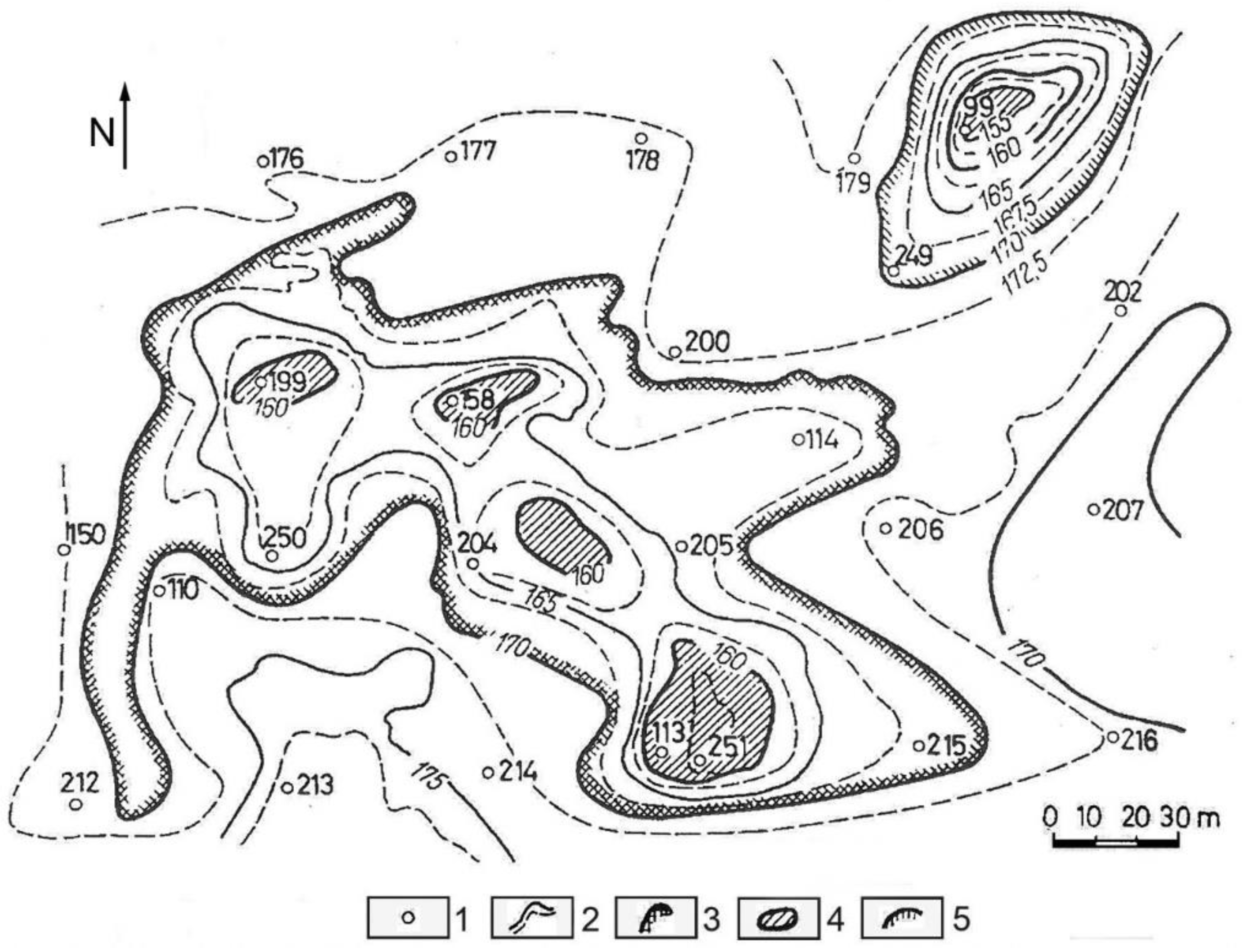
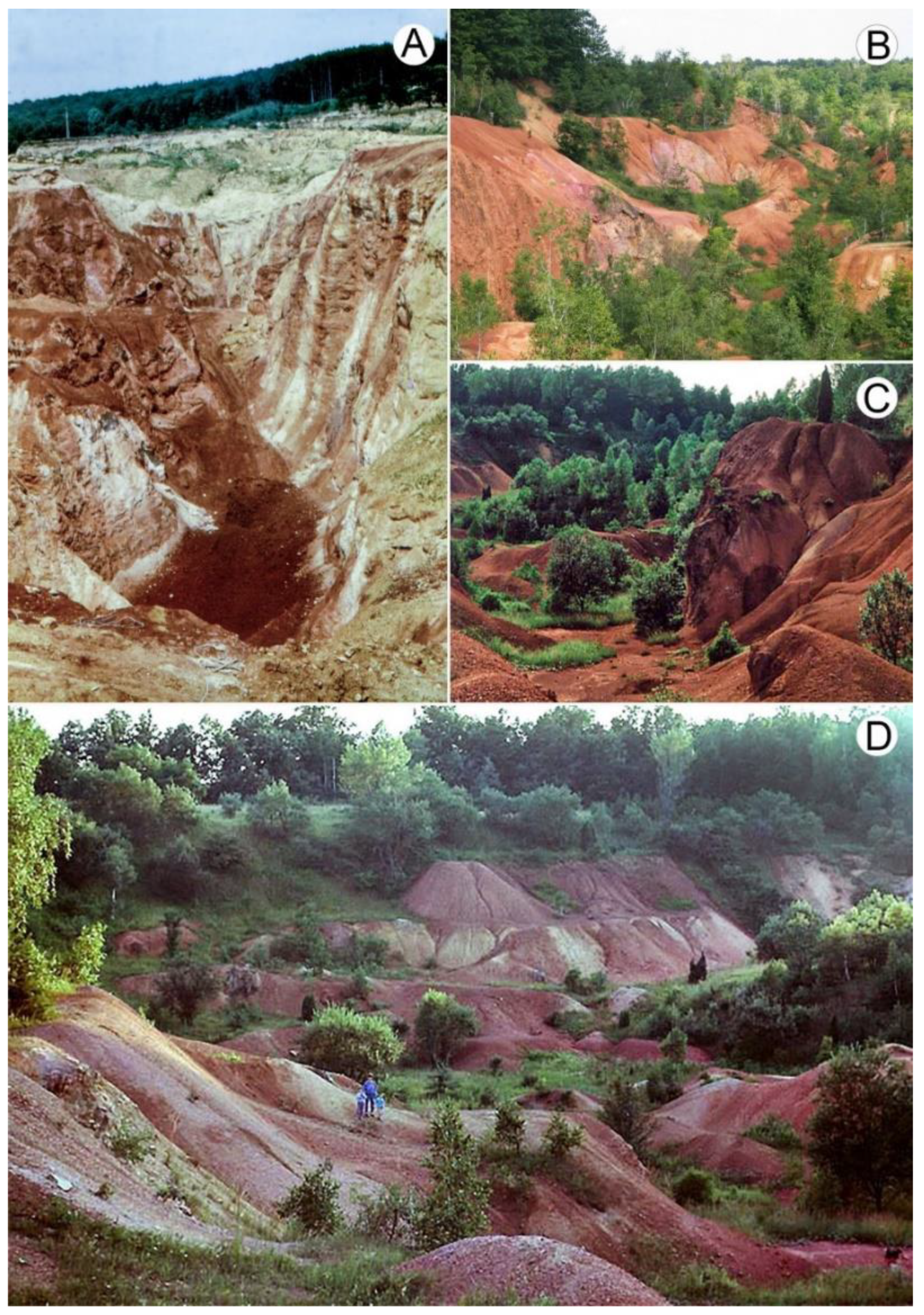
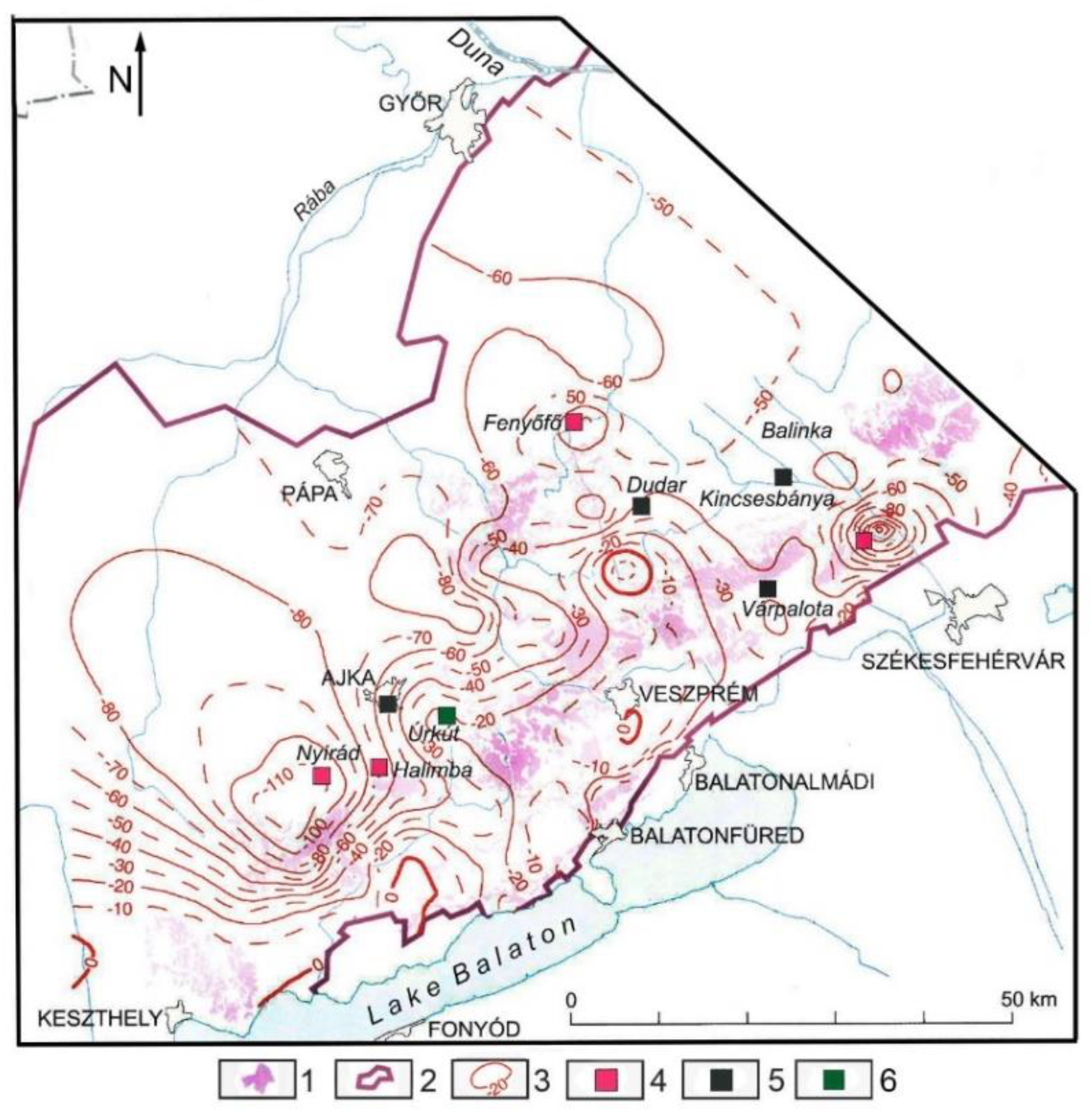
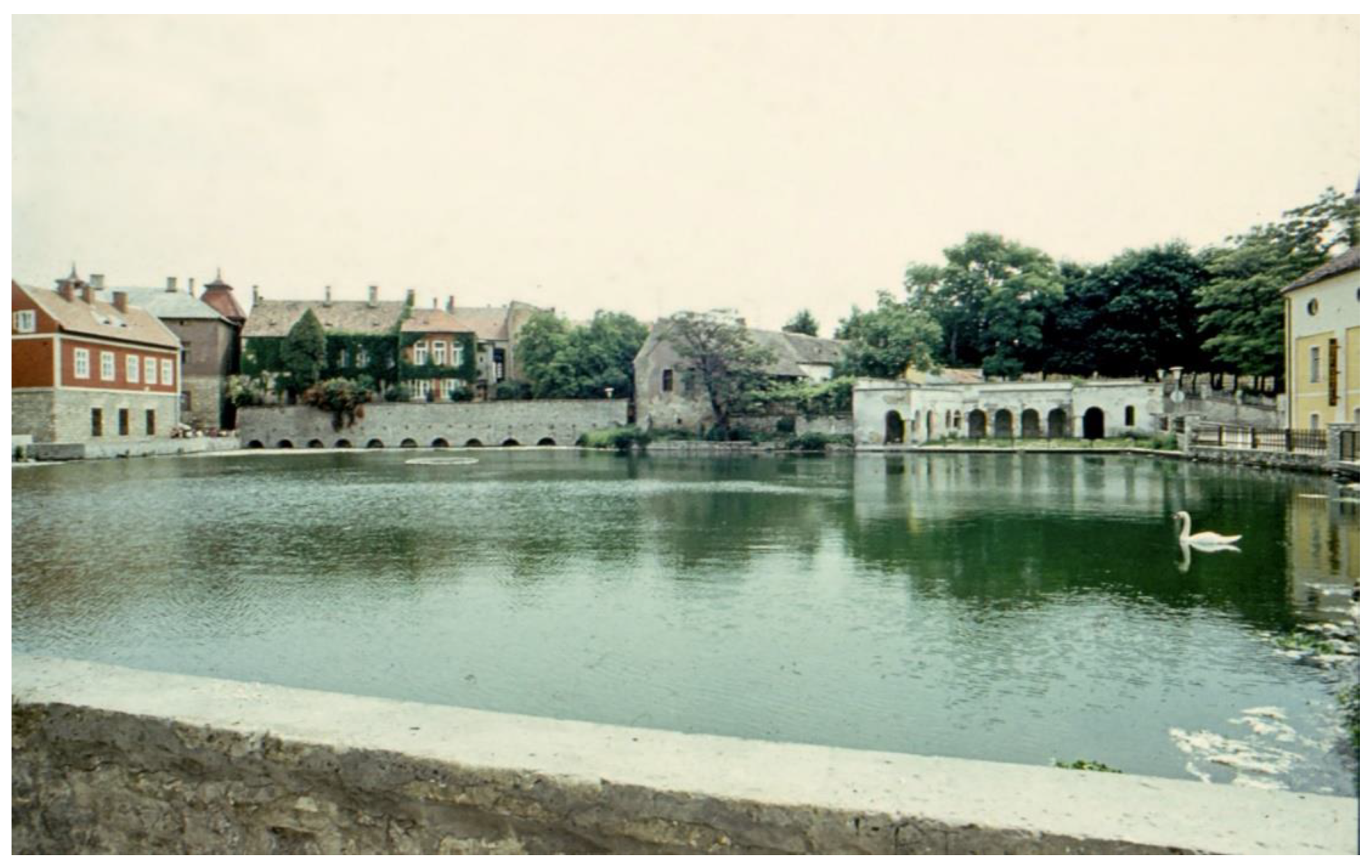
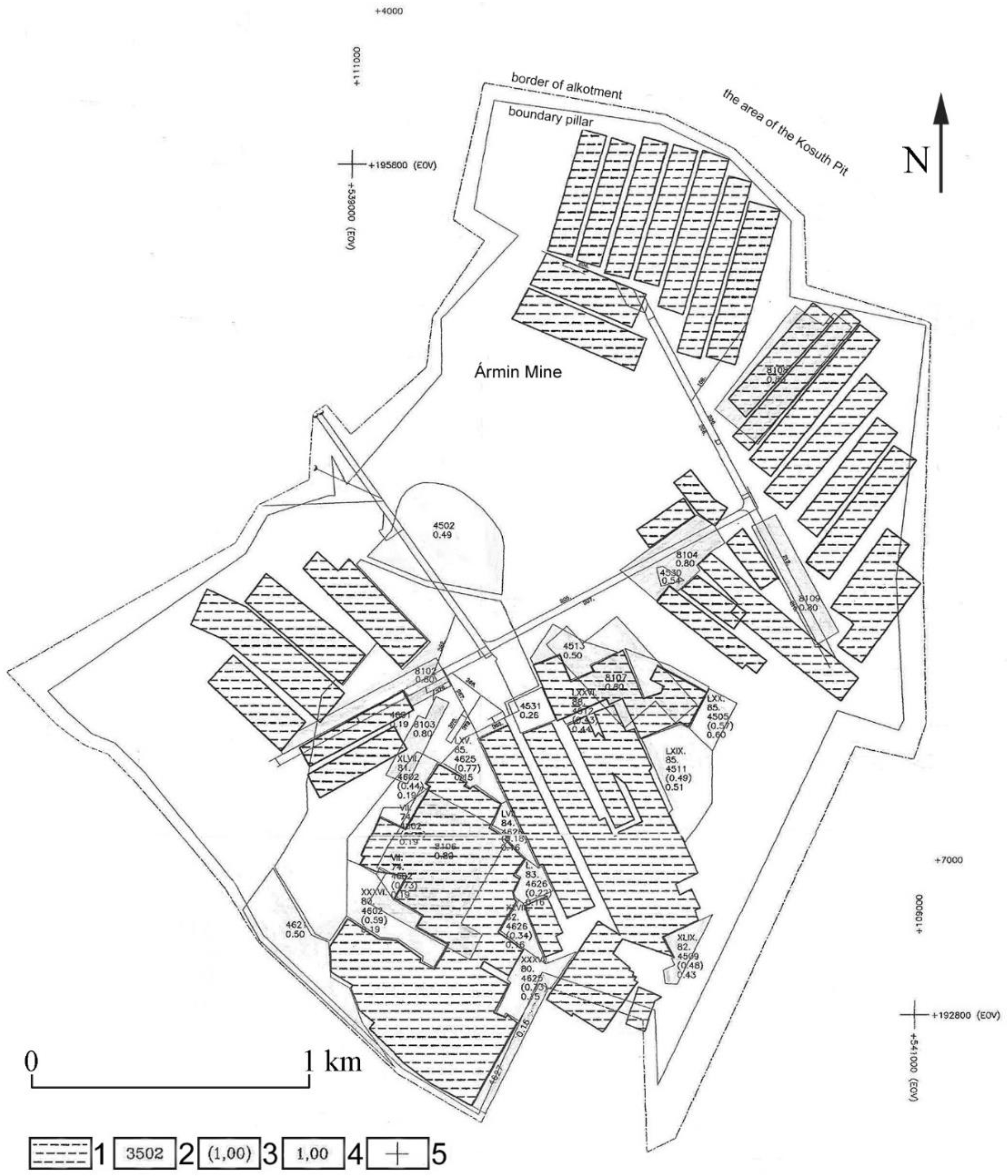
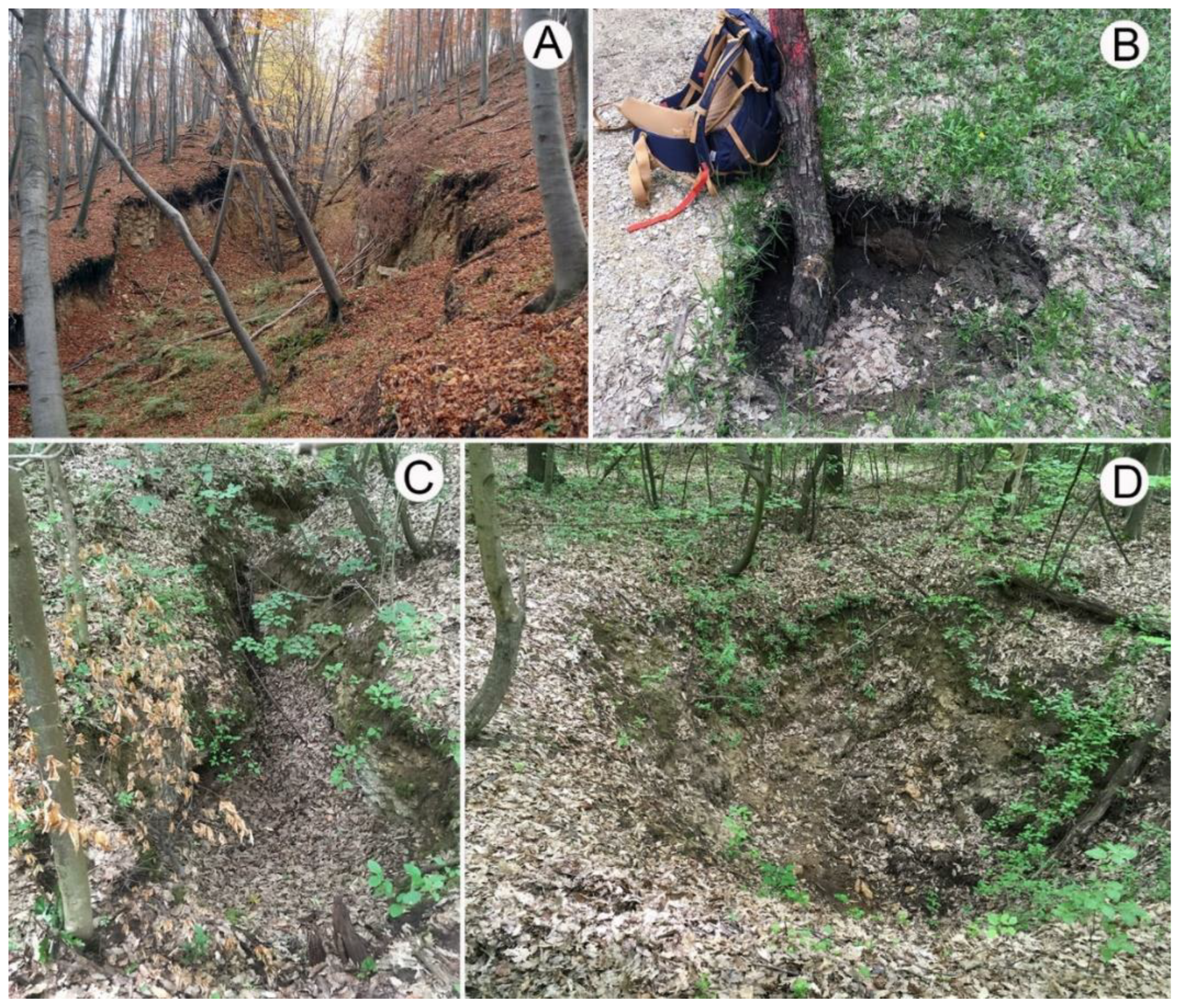

Publisher’s Note: MDPI stays neutral with regard to jurisdictional claims in published maps and institutional affiliations. |
© 2022 by the author. Licensee MDPI, Basel, Switzerland. This article is an open access article distributed under the terms and conditions of the Creative Commons Attribution (CC BY) license (https://creativecommons.org/licenses/by/4.0/).
Share and Cite
Veress, M. The Effect of Mining Activities on the Paleokarstic Features, Recent Karstic Features, and Karst Water of the Bakony Region (Hungary). Mining 2022, 2, 757-768. https://doi.org/10.3390/mining2040042
Veress M. The Effect of Mining Activities on the Paleokarstic Features, Recent Karstic Features, and Karst Water of the Bakony Region (Hungary). Mining. 2022; 2(4):757-768. https://doi.org/10.3390/mining2040042
Chicago/Turabian StyleVeress, Márton. 2022. "The Effect of Mining Activities on the Paleokarstic Features, Recent Karstic Features, and Karst Water of the Bakony Region (Hungary)" Mining 2, no. 4: 757-768. https://doi.org/10.3390/mining2040042
APA StyleVeress, M. (2022). The Effect of Mining Activities on the Paleokarstic Features, Recent Karstic Features, and Karst Water of the Bakony Region (Hungary). Mining, 2(4), 757-768. https://doi.org/10.3390/mining2040042




